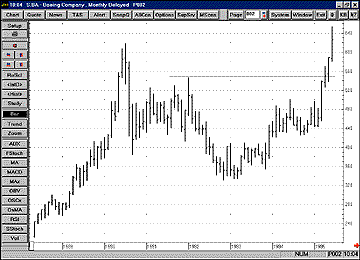In the decades that technical analysis has been rising in prominence, few have been as outspoken as Ralph J. Acampora, CMT, first vice president with Prudential Securities. Acampora has his roots firmly in the discipline. He's been a technician for three decades, he's a regular panelist and technician on the popular television show Wall $treet Week with Louis Rukeyser and not only that, he's a cofounder of the Market Technicians Association. In 1996, he won a place on the second team in the Institutional Investor All-America Research Team in the category of technical analysis. STOCKS & COMMODITIES Editor Thom Hartle spoke with Acampora on November 19, 1996, via a telephone interview, covering a number of topics including the value of using basic research and making use of historical comparisons in the stock market.

"When I came to Wall Street 30 years ago, technical analysis was being used by the big brokerage houses, but it didn't really have much credibility. No one, but no one, was talking to each other on a formal basis about technical analysis. -- Ralph Acampora
Ralph, you were one of the original founders of the Market Technicians Association. How did that organization come into being?
"When I came to Wall Street 30 years ago, technical analysis was being used by many of the big brokerage houses, but it didn't really have much credibility. Second, no one, but no one, was talking to each other on a formal basis about technical analysis."
What happened?
"Then around 1969, I met Johnny Brooks. I must have been 27, he must have been 25, and we talked about how great it would be if technicians got together on a regular basis to talk about technical analysis. So along with John Greeley, we formed the Market Technicians Association, which is known today as the MTA."
When was this?
In 1970. Technical analysis faced a serious issue of credibility. We felt the time had come to change that because, as you might imagine, we believed very strongly in the worth of technical analysis. We felt that we had a lot of quality information, and we were interested in sharing the knowledge with other technicians, because at that time very little was being published. And finally, we weren't being recognized as professionals, and we knew we should be. So those were our goals.
Technical analysis is a universal language. It's used and applied all over the world. It doesn't really make a bit of difference whether you're in Japan, Mexico or New York.
 Figure 1: Boeing [BA], June 1995. Acampora listed more than 150 chart examples in his June 1995 report, Dow 7000. Seven of his examples are stocks that are listed in the Dow Jones Industrial Average. The following figures represent a "Where were they then and where are they now" view. Here, Boeing, after bottoming in late 1992, began an uptrend that returned prices to the 1990 peak.
Figure 1: Boeing [BA], June 1995. Acampora listed more than 150 chart examples in his June 1995 report, Dow 7000. Seven of his examples are stocks that are listed in the Dow Jones Industrial Average. The following figures represent a "Where were they then and where are they now" view. Here, Boeing, after bottoming in late 1992, began an uptrend that returned prices to the 1990 peak.
 Figure 2: Boeing, December 1995. The bull trend continues in Boeing. Recently, Boeing traded above $100 before backing off.
Figure 2: Boeing, December 1995. The bull trend continues in Boeing. Recently, Boeing traded above $100 before backing off.
"A chart is a chart is a chart. You're measuring supply and demand. You're measuring psychology. And they never change. Now you can call a crossover on a moving average a golden cross; you can call it whatever you want. It's still the same thing. That's what makes it so exciting. It's the only financial subject that is consistent from country to country. You can't say that about fundamental analysis, because in fundamental analysis they do things differently in different countries, but you can say that about technical analysis. That's what makes technical analysis so flexible.
Speaking of writing, you're getting a lot of press from a report you published for Prudential Securities back in June 1995.
That's true.
At that time, the Dow Jones Industrial Average (DJIA) was trading around 4500 and you published a report forecasting 7000 for the DJIA, which at the time seemed like a very lofty prediction.
I think that the success of that piece is not so much that the forecast has turned out to be accurate, but that report really demonstrates the true value of technical analysis.
In what way?
If people would accept technical analysis for what it really is and get away from overcomplexity, I think they would find that the forecast I made was there for anyone to find who looked. All these people with computers are doing really interesting work, but I think we tend to overdo it. If you were to get back to the basics and if you had tracked the major trend, then the forecast was there. When the DJIA crossed 4000 in the early part of 1995, it was a major breakout. But so many technicians were fighting it because they were looking at their technical indicators and not the market.


